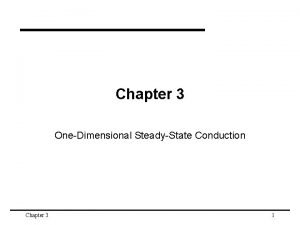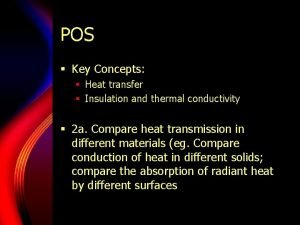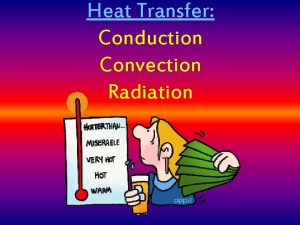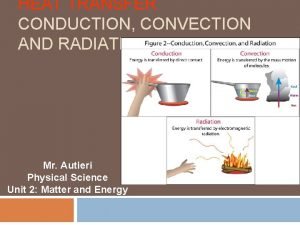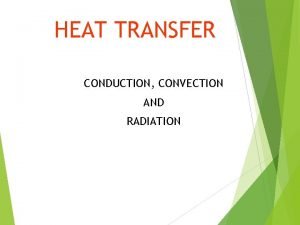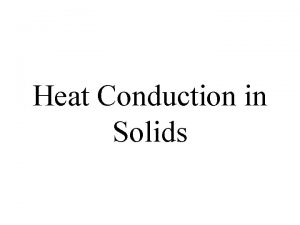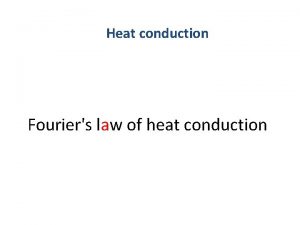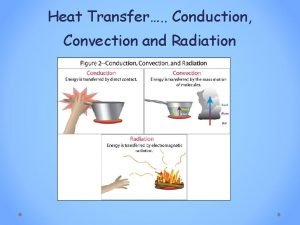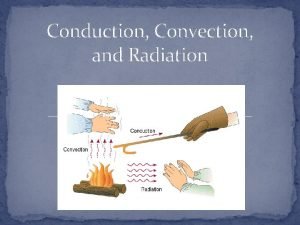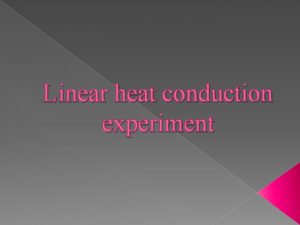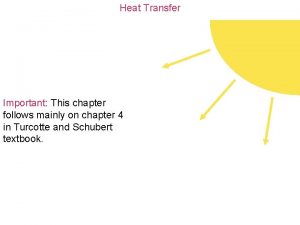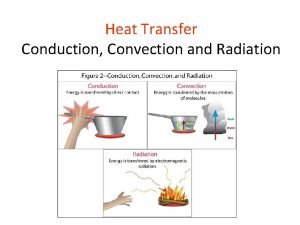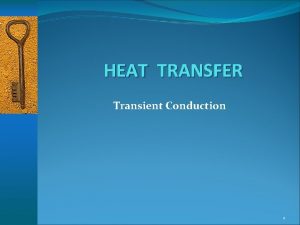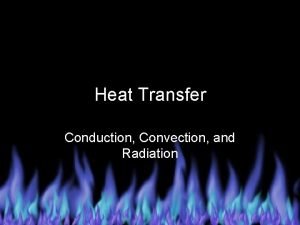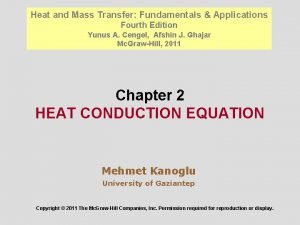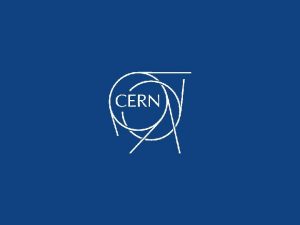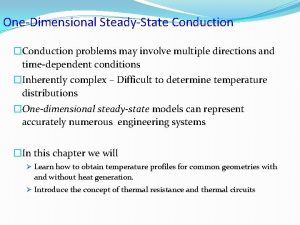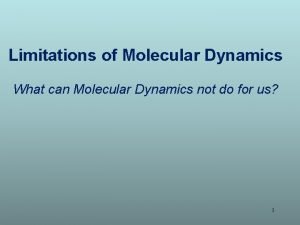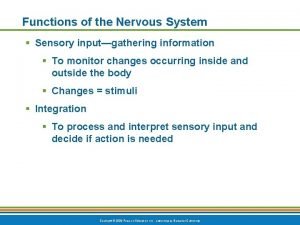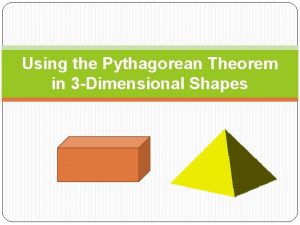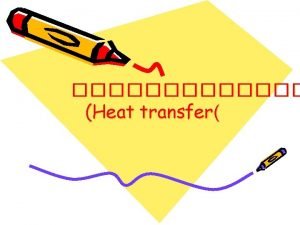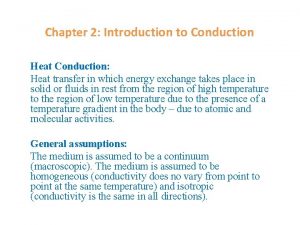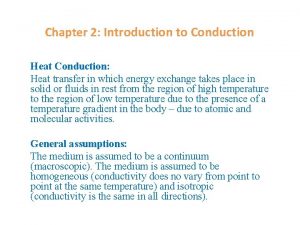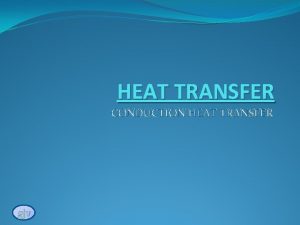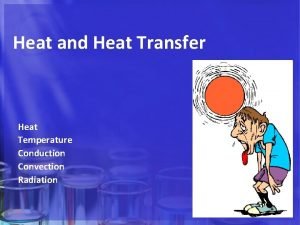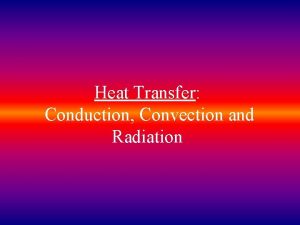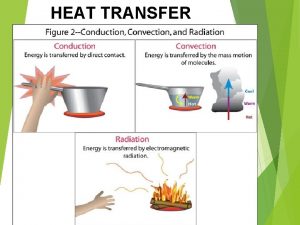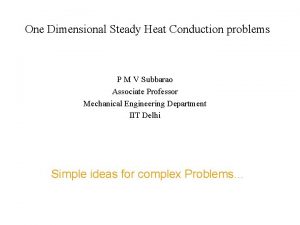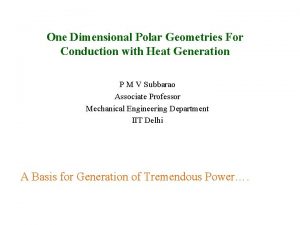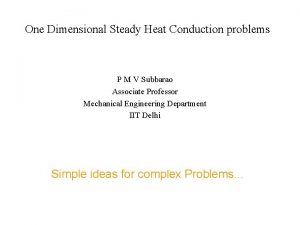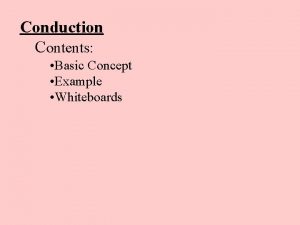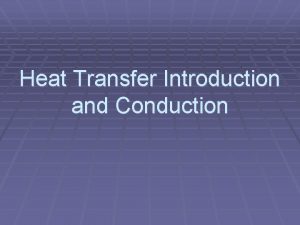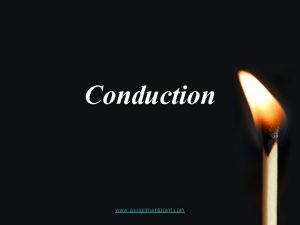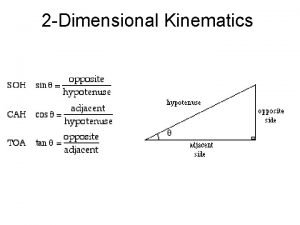Heat Conduction in One Dimensional Systems molecular dynamics






























![Damping Function 1[z] Molecular Dynamics Mode-Coupling Theory From J-S Wang & B Li, PRE Damping Function 1[z] Molecular Dynamics Mode-Coupling Theory From J-S Wang & B Li, PRE](https://slidetodoc.com/presentation_image_h2/9dd4cd4581df416f8badc258044b5c68/image-31.jpg)




![Mode-Coupling || slope = 1/2 slope = 0 2 [z]/p At parameter set B. Mode-Coupling || slope = 1/2 slope = 0 2 [z]/p At parameter set B.](https://slidetodoc.com/presentation_image_h2/9dd4cd4581df416f8badc258044b5c68/image-36.jpg)





- Slides: 41

Heat Conduction in One. Dimensional Systems: molecular dynamics and mode-coupling theory Jian-Sheng Wang National University of Singapore 1

Outline • • Brief review of 1 D heat conduction Introducing a chain model Nonequilibrium molecular dynamics results Projection formulism and mode-coupling theory • Conclusion 2

Fourier Law of Heat Conduction Fourier proposed the law of heat conduction in materials as J = κ T where J is heat current density, κ is thermal conductivity, and T is temperature. Fourier, Jean Baptiste Joseph, Baron (1768 – 1830) 3

Normal & Anomalous Heat Transport TL J TH 3 D bulk systems obey Fourier law (insulating crystal: Peierls’ theory of Umklapp scattering process of phonons; gas: kinetic theory, κ = ⅓cvl ) In 1 D systems, variety of results are obtained and still controversial. See S Lepri et al, Phys Rep 377 (2003) 1, for a review. 4

Heat Conduction in One-Dimensional Systems • 1 D harmonic chain, k N (Rieder, Lebowitz & Lieb, 1967) • k diverges if momentum is conserved (Prosen & Campbell, 2000) • Fermi-Pasta-Ulam model, k N 2/5 (Lepri et al, 1998) • Fluctuating hydrodynamics + Renormalization group, k N 1/3 (Narayan & Ramaswamy 2002) 5

Approaches to Heat Transport • Equilibrium molecular dynamics using linear response theory (Green-Kubo formula) • Nonequilibrium steady state (computer) experiment • Laudauer formula in quantum regime 6

Ballistic Heat Transport at Low Temperature • Laudauer formula for heat current scatter 7

Carbon Nanotube Heat conductivity of Carbon nanotubes at T = 300 K by nonequilibrium molecular dynamics. From S Maruyama, “Microscale Thermophysics Engineering”, 7 (2003) 41. See also G Zhang and B Li, cond-mat/0403393. 8

Carbon Nanotubes Thermal conductance κA of carbon nanotube of length L, determined from equilibrium molecular dynamics with Green. Kubo formula, periodic boundary conditions, Tersoff potential. Z Yao, J-S Wang, B Li, and G-R Liu, condmat/0402616. 9

Fermi-Pasta-Ulam model • A Hamiltonian system with A strictly one-dimensional model. 10

A Chain Model for Heat Conduction ri = (xi, yi) TL m TH Φi Transverse degrees of freedom introduced 11

Nonequilibrium Molecular Dynamics • Nosé-Hoover thermostats at the ends at temperature TL and TH • Compute steady-state heat current: j =(1/N)Si d (ei ri)/dt, where ei is local energy associated with particle i • Define thermal conductance k by <j> = k (TH-TL)/(Na) N is number of particles, a is lattice spacing. 12

Nosé-Hoover Dynamics 13

Defining Microscopic Heat Current • Let the energy density be then J satisfies • A possible choice for total current is 14

Expression of j for the chain model 15

Temperature Profile Temperature of i -th particle computed from k. BTi=<½mvi 2 > for parameter set E with N =64 (plus), 256 (dash), 1024 (line). 16

Conductance vs Size N Model parameters (KΦ, TL, TH): slope=1/3 Set F (1, 5, 7), B (1, 0. 2, 0. 4), E (0. 3, 0. 5), H (0, 0. 3, 0. 5), J (0. 05, 0. 1, 0. 2) , slope=2/5 ln N m=1, a=2, Kr=1. From J-S Wang & B Li, Phys Rev Lett 92 (2004) 074302. 17

Additional MD data Parameters (KΦ, TL, TH, ε), set L(25, 1, 1. 5, 0. 2) G(10, 0. 2, 0. 4, 0) K(0. 5, 1. 2, 2, 0. 4) I(0. 1, 0. 3, 0. 5, 0. 2) C(0. 1, 0. 2, 0. 4, 0) From J-S Wang and B Li, PRE, 70, 021204 (2004). 18

Mode-Coupling Theory for Heat Conduction • Use Fourier components as basic variables • Derive equations relating the correlation functions of the variables with the damping of the modes, and the damping of the modes to the square of the correlation functions • Evoke Green-Kubo formula to relate correlation function with thermal conductivity 19

Basic Variables (work in Fourier space) 20

Equation of Motion for A Formal solution: 21

Projection Operator & Equation • Define • We have • Apply P and 1−P to the equation of motion, we get two coupled equations. Solving them, we get 22

Projection Method (Zwanzig and Mori) • Equation for dynamical correlation function: where G(t) is correlation matrix of normalmode Canonical coordinates (Pk, Qk). G is related to the correlation of “random” force. 23

Definitions L is Liouville operator 24

Correlation function equation and its solution (in Fourier. Laplace space) • Define the equation can be solved as in particular 25

Small Oscillation Effective Hamiltonian Equations of motion 26

Equation of Modes 27

Determine Effective Hamiltonian Model Parameters from MD 28

Mode-Coupling Approximation • G(t) = b <R(t) R(0)> • R QQ • G(t) <Q(t)Q(0)> = g(t) [mean-field type] 29

Full Mode-Coupling Equations is Fourier-Laplace transform of 30
![Damping Function 1z Molecular Dynamics ModeCoupling Theory From JS Wang B Li PRE Damping Function 1[z] Molecular Dynamics Mode-Coupling Theory From J-S Wang & B Li, PRE](https://slidetodoc.com/presentation_image_h2/9dd4cd4581df416f8badc258044b5c68/image-31.jpg)
Damping Function 1[z] Molecular Dynamics Mode-Coupling Theory From J-S Wang & B Li, PRE 70, 021204 (2004). 31

Correlation Functions Correlation function g(t) for the slowest longitudinal and transverse modes. Black line: modecoupling, red dash: MD. N = 256. g(t) e- tcos(ωt) 32

Decay or Damping Rate Decay rate of the mode vs mode index k. p = 2πk/(Na) is lattice momentum. N = 1024. slope=3/2 longitudinal slope=2 transverse Symbols are from MD, lines from mode-coupling theory. Straight lines have slopes 3/2 and 2, respectively. 33

Mode-Coupling Theory in the Continuum Limit 34

Asymptotic Solution • The mode-coupling equations predict, for large system size N, and small z : If there is no transverse coupling, Γ = z(-1/3)p 2 (Result of Lepri). 35
![ModeCoupling slope 12 slope 0 2 zp At parameter set B Mode-Coupling || slope = 1/2 slope = 0 2 [z]/p At parameter set B.](https://slidetodoc.com/presentation_image_h2/9dd4cd4581df416f8badc258044b5c68/image-36.jpg)
Mode-Coupling || slope = 1/2 slope = 0 2 [z]/p At parameter set B. Blue dash : asymptotic analytical result, red line : Full theory on N =1024, solid line : N limit theory 36

Green-Kubo Formula 37

Green-Kubo Integrand Parameter set B. Red circle: molecular dynamics, solid line: modecoupling theory (N = 1024), blue line: asymptotic slope of 2/3. 38

k. N with Periodic Boundary Condition slope=1/2 Molecular dynamics Mode-coupling κ from Green. Kubo formula on finite systems with periodic boundary conditions, for parameter set B (Kr=1, KΦ=1, T=0. 3) 39

Relation between Exponent in Γ and κ • If mode decay with Γ≈z-δp 2, then • With periodic B. C. thermal conductance κ ≈ N 1 -δ • With open B. C. κ ≈ N 1 -1/(2 -δ) • Mode coupling theory gives δ=1/2 with transverse motion, and δ=1/3 for strictly 1 D system. 40

Conclusion • Quantitative agreement between modecoupling theory and molecular dynamics is achieved • Molecular dynamics and mode-coupling theory support 1/3 power-law divergence for thermal conduction in 1 D models with transverse motion, 2/5 law if there are no transverse degrees of freedom. 41
 One dimensional steady state conduction
One dimensional steady state conduction Circular motion is one dimensional or two dimensional
Circular motion is one dimensional or two dimensional Radial conduction
Radial conduction Heat transfer by conduction gizmo
Heat transfer by conduction gizmo Transient heat transfer in industry
Transient heat transfer in industry Example of conduction heat transfer
Example of conduction heat transfer What is heat transfer conduction convection and radiation
What is heat transfer conduction convection and radiation Example of radiation
Example of radiation Radiation heat transfer examples
Radiation heat transfer examples Heat loss in babies
Heat loss in babies โจทย์ heat transfer พร้อมเฉลย
โจทย์ heat transfer พร้อมเฉลย Radial heat conduction
Radial heat conduction Method of heat transfer
Method of heat transfer What is radiation examples
What is radiation examples Linear heat conduction experiment
Linear heat conduction experiment Transfer heat
Transfer heat Examples of radiation heat transfer
Examples of radiation heat transfer Heat energy transfer
Heat energy transfer 5'0 in cm
5'0 in cm Example of conduction
Example of conduction Variable thermal conductivity
Variable thermal conductivity Heat conduction expert
Heat conduction expert Thermal resistance formula
Thermal resistance formula Fourier's law of conduction
Fourier's law of conduction Electrical analogy in heat transfer
Electrical analogy in heat transfer Giant molecular structure vs simple molecular structure
Giant molecular structure vs simple molecular structure Giant molecular structure vs simple molecular structure
Giant molecular structure vs simple molecular structure Giant molecular structure vs simple molecular structure
Giant molecular structure vs simple molecular structure Molecular dynamics limitations
Molecular dynamics limitations Nervous cell
Nervous cell One empire one god one emperor
One empire one god one emperor One one one little dogs run
One one one little dogs run One king one law one faith
One king one law one faith One god one empire one emperor
One god one empire one emperor Ford one plan
Ford one plan See one do one teach one
See one do one teach one See one, do one, teach one
See one, do one, teach one Night structure
Night structure Studiendekanat uni bonn
Studiendekanat uni bonn One vision one identity one community
One vision one identity one community Asean one vision one identity one community
Asean one vision one identity one community Pythagorean theorem three dimensions
Pythagorean theorem three dimensions
